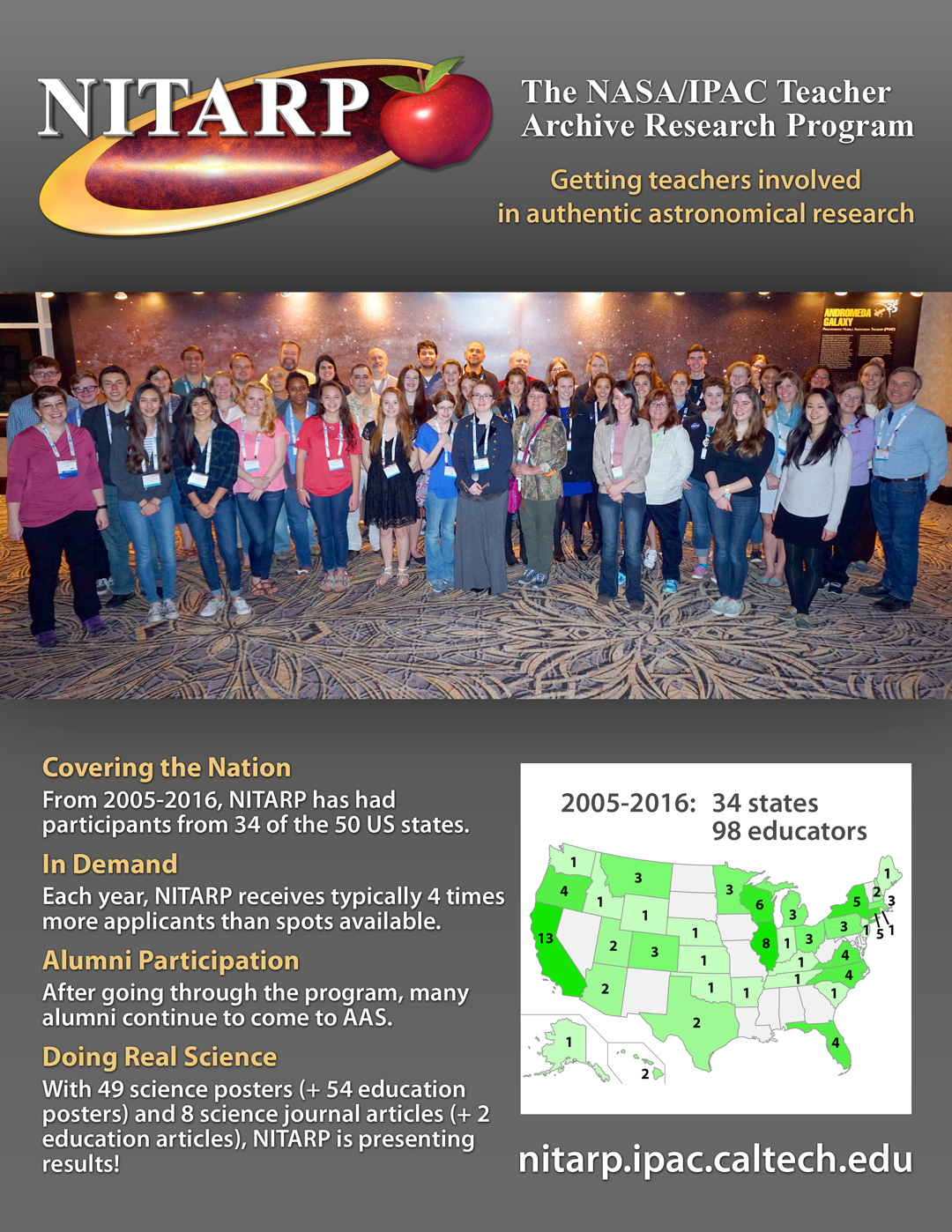
Teacher Program Brings NASA Research to Schools across America

How many high school teachers and students can say they have presented their astronomy research alongside professional scientists at an international conference? Participants in NITARP can!
More than 50 teachers, students and astronomy educators from the NASA/IPAC Teacher Archive Research Program (NITARP) will be attending the winter meeting of the American Astronomical Society (AAS), running from January 4 through January 8 in Kissimmee, Florida.
For over a decade now, NITARP has partnered small groups of educators with a research astronomer for original, year-long, authentic research projects. At the AAS meeting, the educators from the 2015 class, along with some of their students, are presenting the results of their work over the past year. Meanwhile, the educators from the 2016 class will meet their teams and get started on their own projects.
In addition, nine self-funded NITARP teacher alumni are also returning to AAS to network and showcase projects they have done after being intensively involved in the program. A NITARP alumni educator's student will attend the meeting as well.
[To learn more about the returning NITARP alumni, please read an associated press release from IPAC, available here.]
A total of 98 educators from 34 states have participated or will participate in 2016. NITARP works with educators because, through them, NITARP reaches thousands of students per year with information about how science really works, what NASA does, and the wealth of astronomy data that is freely available to the public.
Here are the teams that are presenting posters at the AAS meeting this week:
2015 team working with Dr. Varoujan Gorjian (JPL/IPAC):
• John Gibbs (Glencoe High School, Hillsboro, OR) – mentor teacher for the team
• Robert Palmer (Willmar Senior High, Willmar, MN)
• Lee Pruett (Notre Dame High School, San Jose, CA)
• Diedre Young (Ridgeway Christian High School, Pine Bluff, AR)
This team combined data from the Sloan Digital Sky Survey (SDSS; optical) and the Two-Micron All-Sky Survey (2MASS; infrared) to construct a color-magnitude diagram of Type I active galactic nuclei (AGN). The best color-magnitude correlation was found between the SDSS z and 2MASS Ks bands for redshifts between 0.07 and 0.08.
2015 team working with Dr. Luisa Rebull (IPAC):
• Caroline Odden (Phillips Academy, Andover, MA) – mentor teacher for the team
• Garrison Hall (L. E. Gable Middle School, Roebuck, SC and University of South Carolina Upstate, Greenville, SC)
• Richard Sanchez (Clear Creek Middle School, Buffalo, WY)
This team used infrared data from the Widefield Infrared Survey Explorer (WISE), combined with optical and near-infrared data from other archives and data from the literature. They searched for young stars in a region called IC417, near which several young clusters are thought to reside. They discovered more than 100 young stars.
The 2015 educators will now go on to conduct at least 12 hours of professional development for their colleagues in their schools and communities, at the local, regional, and national levels, in print and in person.
NITARP is announcing today the 2016 class of educators and their teams, as follows:
2016 team working with Dr. Varoujan Gorjian (JPL/IPAC):
• Thomas Rutherford (Sullivan South High School, Kingsport, TN) – mentor teacher for the team
• Kelly Kilts (Lexington High School, Lexington, MA)
• Russell Kohrs (Massanutten Regional Governor's School for Integrated Environmental Science and Technology, Mount Jackson, VA)
• Vincent Urbanowski (Academy of Information Technology & Engineering, Stamford, CT)
2016 team working with Dr. Luisa Rebull (IPAC):
• Laura Orr (Ukiah High School, Ukiah, OR) – mentor teacher for the team
• Mackenzie Schultz (High Tech High Chula Vista, Chula Vista, CA)
• Milton Johnson (Bioscience High School, Phoenix, AZ)
• Alexandra Miller (Milken Community Schools, Los Angeles, CA)
They will present their results, with their students, at the 2017 AAS winter meeting to be held in Grapevine, TX.
The Infrared Processing and Analysis Center (IPAC), based at Caltech, in Pasadena, CA, is leading this program. These teams use archival data from the Spitzer Space Telescope (part of the Spitzer Heritage Archive, SHA), the NASA/IPAC Extragalactic Database (NED), the NASA Exoplanet Archive, the NASA/IPAC Infrared Science Archive (IRSA), all of which are based at IPAC, and other NASA archive holdings. Funding comes from the NASA Astrophysics Data Program.
- Date: January 6th, 2016
- Category: Project News
- View Image


